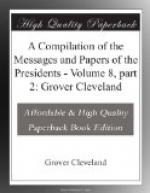The entire bill is most unfortunately constructed. Nearly every sentence presents uncertainty and invites controversy as to its meaning and intent. The first section is especially faulty in this respect, and it is extremely doubtful whether its language will permit the consummation of its supposed purposes. I am led to believe that the promoters of the bill intended in this section to provide for the coinage of the bullion constituting the gain or seigniorage, as it is called, into standard silver dollars, and yet there is positively nothing in the section to prevent its coinage into any description of silver coins now authorized under any existing law.
I suppose this section was also intended, in case the needs of the Treasury called for money faster than the seigniorage bullion could actually be coined, to permit the issue of silver certificates in advance of such coinage; but its language would seem to permit the issuance of such certificates to double the amount of seigniorage as stated, one-half of which would not represent an ounce of silver in the Treasury. The debate upon this section in the Congress developed an earnest and positive difference of opinion as to its object and meaning. In any event, I am clear that the present perplexities and embarrassments of the Secretary of the Treasury ought not to be augmented by devolving upon him the execution of a law so uncertain and confused.
I am not willing, however, to rest my objection to this section solely on these grounds. In my judgment sound finance does not commend a further infusion of silver into our currency at this time unaccompanied by further adequate provision for the maintenance in our Treasury of a safe gold reserve.
Doubts also arise as to the meaning and construction of the second section of the bill. If the silver dollars therein directed to be coined are, as the section provides, to be held in the Treasury for the redemption of Treasury notes, it is suggested that, strictly speaking, certificates can not be issued on such coin “in the manner now provided by law,” because these dollars are money held in the Treasury for the express purpose of redeeming Treasury notes on demand, which would ordinarily mean that they were set apart for the purpose of substituting them for these Treasury notes. They are not, therefore, held in such a way as to furnish a basis for certificates according to any provision of existing law.




